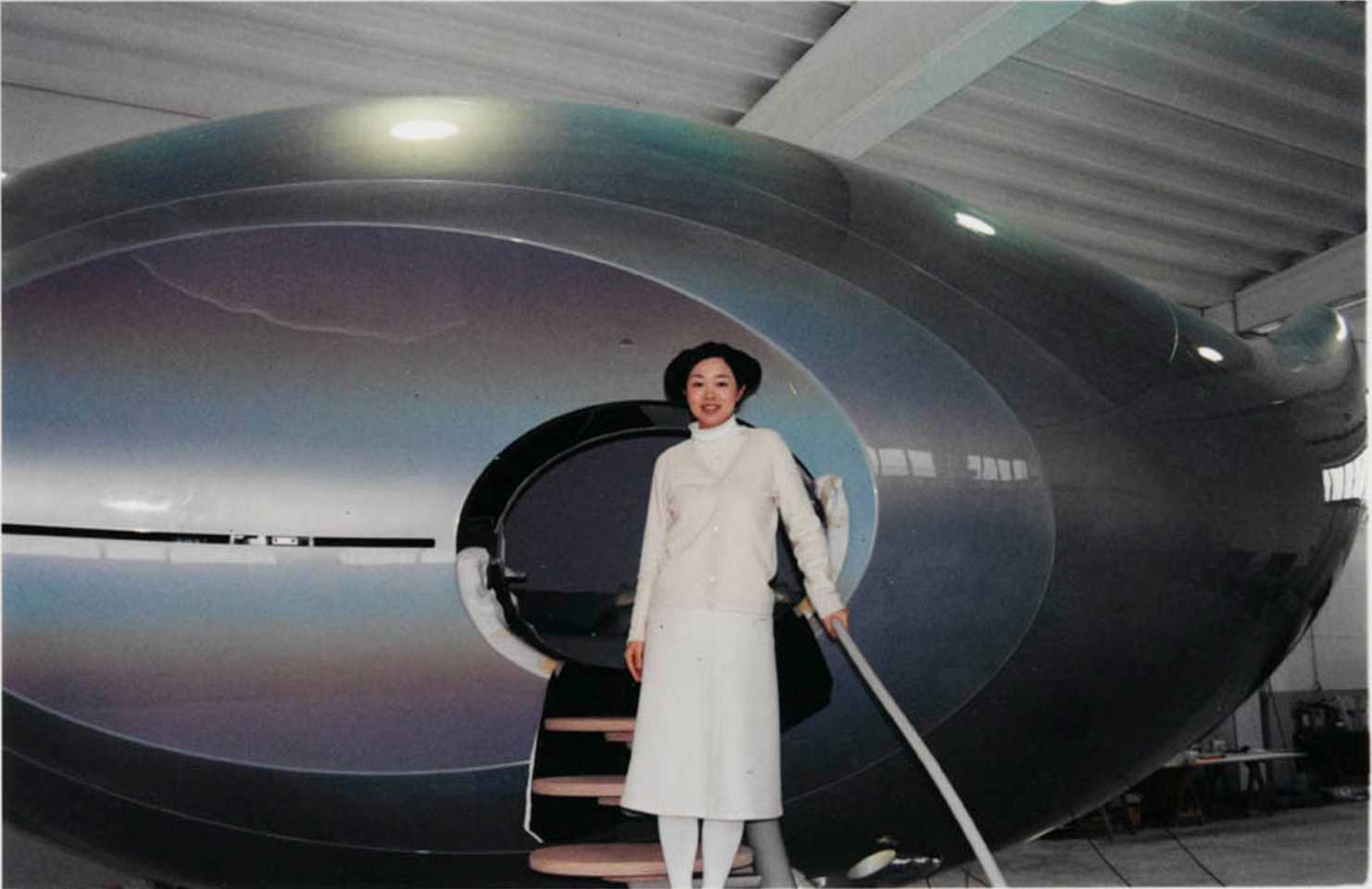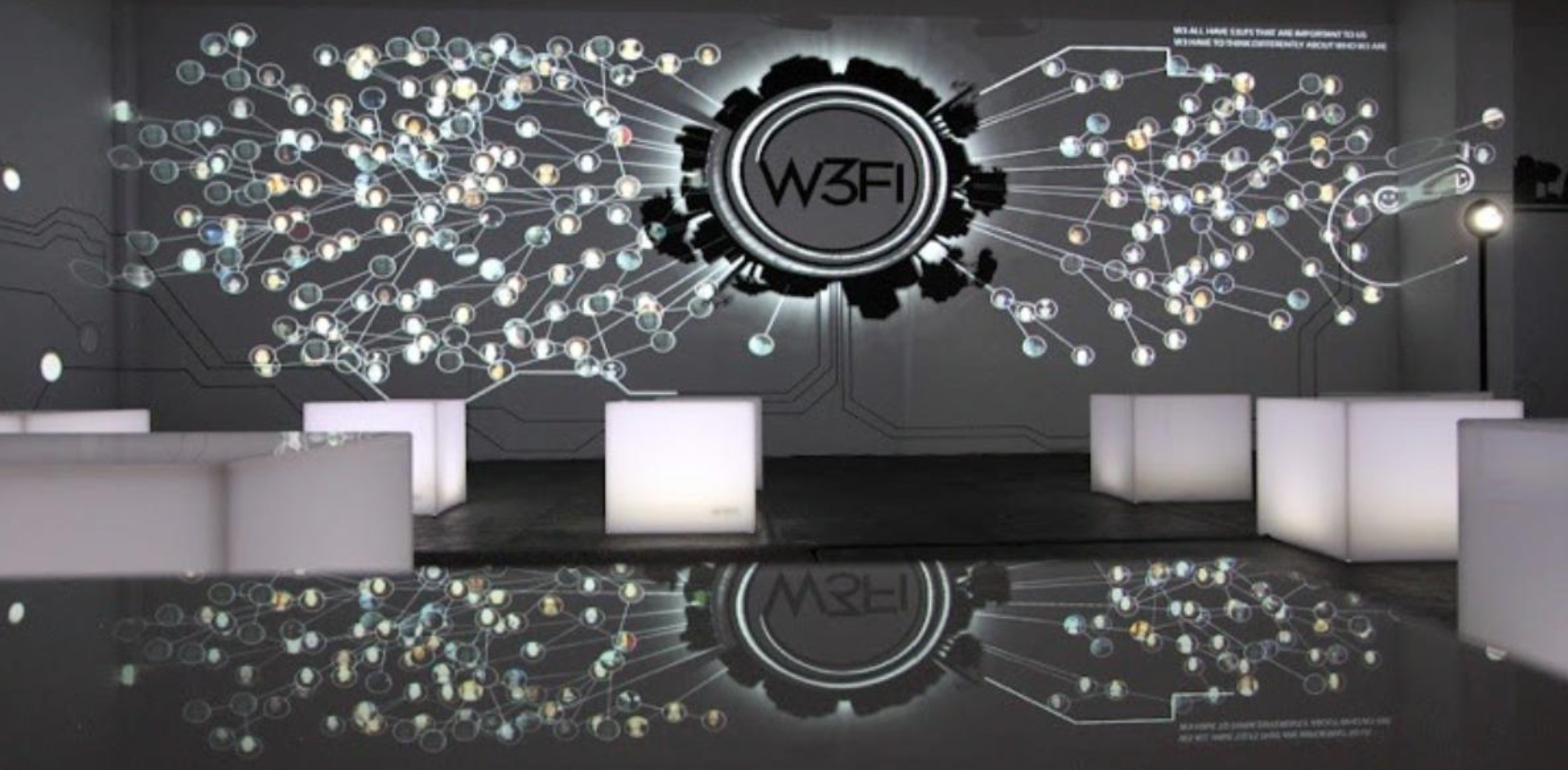Wave UFO
Japanese photographer, sculptor, and digital artist Mariko Mori is transcendent in her approach to enveloping a viewer with her futuristic visions. Mori’s work in creating interactive spaces pushes this concept even further. Such as would be 2003’s Wave UFO. The installation blends art, architecture, music, science, and performance into one condensed zone of introspection.
Wave UFO is a large-architectural sculpture that took Mori over three years to produce. She found a great deal of inspiration from her research of the automobile factories in Turin, Italy. Featured as a stand-alone piece, the metallic work took up a whole room and was toured extensively across the globe. The fiberglass, droplet-esque structure stands 14-feet tall, 17-feet wide, and 34-feet long. To reach the inner sanctum of the three dimensional Wave UFO , one must traverse the lilypad staircase and through the clear, electronic bubble door. While the architectural vessel itself is remarkably impressive, it is through this entryway that the astounding interactivity occurs.
“In a computer-animated video projection, Mori sends the "travelers" on a trip to a spiritual cosmos” Kunsthaus Bregenz, 2003.
Only three can enter the inner capsule of Wave UFO at a time. Once inside the inner cavity of the piece, the three viewers are seated in three Technogel chairs. Technogel is an polyurethane gel synthesized by the Italian of the same name. The gel in these chairs mold to fit the form of each and every participant without ever hardening and allow for the viewers to take this journey in the utmost comfort. Before entering Wave UFO, each of the three participants are outfitted with a set of electrodes. These serve the purpose of accessing and gathering data of the brainwaves of the participants for the most spectacular function of the piece. This data is transformed into visualizations that correspond in real-time with each of the participants current brain activity. This is then projected onto the screens that make up the ceilings of the Wave UFO. Each participant's brain activity is represented by two amorphous cells, one for either lobe. Each cell, though lacking a constant shape, is represented by a colorful, undulating line that moves in correlation to the movement of each participant’s face. The colorization and shape of the cells constantly changes and shifts to illuminate the most dominant reactions. Each particular brainwave has it’s own color and is symbolic of it’s own reaction.
“Alpha waves are blue and indicate wakeful relaxation. Beta waves are pink and indicate alertness or agitation. Theta waves are yellow and indicate a dreamlike state. When two cells come together it demonstrates "coherence" between the two lobes of the brain” Public Art Fund, May 10, 2003.
The characteristics of the graphics can immediately shift when brain activities become complex, like if a participant tried to solve a complicated math equation or think in another language. This sect of projections make up the first half of the seven minute video projected onto the ceilings, titled Real Time Brain Wave. Real Time Brain Wave continues into Connected World. This final aspect of the projections links the biofeedback to a series of animations based on paintings by Mori. Simultaneously otherworldly and primordial, these abstractions create a dream sequence of constantly shifting biological structures, such as cells and molecules. This combination of biofeedback and surreal animation is Mori’s fusion of the self and universe.
“Drawing upon the Buddhist principle that all forms of life in the universe are interconnected, Wave UFO seamlessly unites actual individual physical experience with Mori's singular vision of a cosmic dream world” Public Art Fund, May 10, 2003.
This fusion is the ultimate aim of Mariko Mori’s piece. To show the beauty of our consanguinity with all of life around us. Whether we acknowledge it or not, we are constantly tapped into all that exists and this interweaving of existence acts as constant influence. In converging the brain activity of three people and projecting the conglomeration of their minds, Mori literally paints a moving picture of this deeper, Buddhist concept. The visualizations of brain activity are allusitory to another Buddhist principle, Nirvana. Nirvana is obtained when the deepest distressing states of being from the depths of the mind are exposed, thus breaking the cycle of reincarnation and therefore suffering. The imagery of brainwave data acts as a mode in which to reach this heightened state, as the hidden truths of the subconscious are projected above each individual. In painting the ceiling over their heads with the emotions and thoughts that swim deep beneath the surface of consciousness, Mori has created a vessel in which people can not only get closer with both themselves and universe but closer to Nirvana itself. Mariko Mori brilliantly discusses ancient principles using an futuristic mediums, thus thrusting these dogmas into our modern day.
This is not Mori’s first attempts at creating modern interactive spaces to interpret ancient Buddhist principles and methodologies. For example her 1999 piece, Dream Temple. Dream Temple is also a structural creation used to invoke a spiritual experience. The structure pays homage to Japan’s oldest Buddhist Temple, Yumedono. One enters the interpretation of the temple to meditate, they reach a chamber in the depths of the structure and stream spacey electronic music through headphones. They meditate before a concave screen, that Mariko Mori animates with 4 minutes with of abstract cosmic imagery. Much like the Wave UFO, Mori’s Dream Temple is an incredibly personalized experience. Entrance is by appointment only and one can only enter alone. Both works utilize modern technologies to invoke Buddhist teachings, Dream Temple using electronic music and animated projections to guide one through a Buddhist meditation. The only major difference is Dream Temple structurally conjures a Buddhist sensationalism, while Wave UFO architecturally brings about a galactic feel.
Image courtesy of Richard Learoyd
Her work is akin to that of Tmema’s Reface, the collaboration team of Golan Levin and Zachary Lieberman, in that they are both spaces created to allow for interactivity between humans. Reface is a portrait sequencer that creates video mash-ups of visitors faces. This was inspired the Victorian Parlor game Exquisite Corpse and uses face tracking techniques which allows for automatic segmentation and alignment of the various faces, this allows visitors to move freely around the camera without worry of throwing off the camera with unalignment. The video clips are edited by the participants blinking, a blink triggering each new set of face combinations. The two works though very different in form and structure both aim to show that we are constantly connecting to others, stranger and familiar face alike. That we converge and don’t even realize it. Click here to view Tmema’s documentation of Reface.
Image courtesy of http://www.flong.com/projects/reface/
Mariko Mori’s work is invigorating, thrusting a viewer into a meditative space. Her spaces offering a look deep into oneself, while also painting incredible visuals of the universe allowing us to get a better sense of our place and our connection to it.
A short documentary featuring a young Italian art students journey and experience within Wave UFO at Venice’s Biennale in 2005 is available to view by clicking here!
Wave UFO premiered at the Kunsthaus Bregenz in Austria, was featured in Venice’s Biennale during its vast tour of the world, and was later housed by the Public Art Fund in NYC.
Additional Press:
>https://www.publicartfund.org/view/exhibitions/5825_wave_ufo#project_about
>https://teachartwiki.wikispaces.com/Mariko+Mori+-+Wave+UFO
>http://www.orbit.zkm.de/?q=node/145
>http://www.nytimes.com/2003/05/08/garden/08UFOO.html
>http://thesystemis.com/projects/reface/









